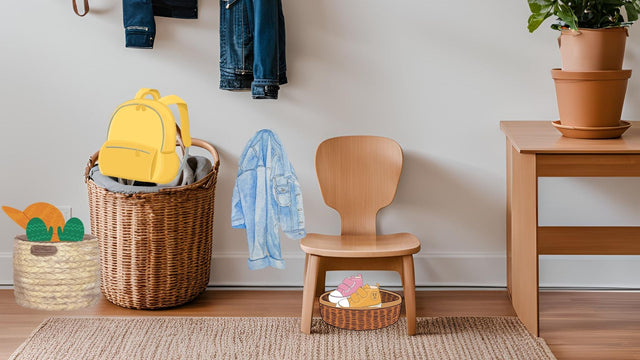What kids can do for themselves from 0-6
As parents, one of our greatest responsibilities is to help our children grow into confident, capable adults. In a Montessori home, independence isn’t just a milestone—it’s a journey.
Building Independence at Home: A Montessori Guide for Parents
By observing your child, making simple adjustments to their environment, and offering guidance when needed, you can nurture their ability to care for themselves, their surroundings, and others.
Let’s start with a vision: What does an independent child look like by the age of six?
The Portrait of an Independent Six-Year-Old
At six years old, children are still navigating the complex journey of independence. This portrait isn’t a checklist of things every child will achieve but rather a vision we can use to inspire small, intentional steps. Independence ebbs and flows as children move through periods of development and consolidation, where they refine what they’ve learned before leaping into new challenges.
Let’s shift away from the “all or nothing” mindset and instead focus on creating openings for growth, while honoring the natural rhythm of your child’s development.
Tasks They May Be Fully Independent With:
These are foundational skills your child might confidently manage on their own:
Self-care
Dressing themselves, using the toilet, and washing their hands.
Simple household contributions
Wiping spills, sweeping, and tidying up toys or materials.
Basic kitchen tasks
Setting the table, clearing their dishes, and washing a few items, fetching and returning items to the fridge and freezer
Food prep + meals
Chopping veggies, cutting up and peeling fruits, serving food onto plates, preparing snack trays with a mix of goods, spooning condiments, filling up cups from a small jug
Small upkeep tasks
Replacing toilet paper rolls or folding washcloths.
Tasks They May Need Guidance or Support For:
These tasks represent growing skills that might require reminders, modeling, or occasional assistance:
Kitchen and cooking:
Stirring or mixing food as it cools, following a simple recipe like making scrambled eggs, pouring from large jugs.
Bathing and hygiene:
Washing hair or brushing teeth thoroughly.
Keeping personal spaces tidy
Making the bed or organizing toys.
Helping with housework
Vacuuming, dusting, or watering plants.
Planning and preparing meals
Measuring ingredients or following a simple recipe.
Areas of Emerging Independence:
Children in this phase often begin developing more complex cognitive skills, but progress here may be slow, uneven, and vary greatly:
Social skills:
Resolving conflicts, cooperating in group settings, or taking turns.
Emotional regulation:
Naming and managing feelings during moments of frustration or disappointment.
Study skills:
Completing small projects, following multi-step instructions, or managing simple homework tasks.
Financial awareness:
Recognizing the value of money through saving or making small purchases.
Commitments:
Starting to honor schedules, like attending extracurricular activities or helping with family routines.
A Montessori Reminder: The Natural Growth Pattern
As parents, it’s easy to feel like our child must master all of these skills right away. Remember that independence develops in cycles:
Development: Children take in new skills, often experimenting and needing lots of support.
Consolidation: They pause to refine and master what they’ve learned before moving forward again.
These 3-year cycles occur throughout Montessori’s Planes of Development. Growth isn’t linear—it’s dynamic and layered. When your child regresses in one area, it’s often because their focus has shifted to mastering something new. Trust the process and give them time to find their balance.
Step 1: Independence Inventory
To begin fostering this vision, start by assessing where your child currently stands. Take note of:
a. Tasks they can do fully independently.
b. Tasks they can do with some guidance.
c. Areas where they show emerging interest but need support.
This inventory will help you identify specific areas to focus on while celebrating the skills they’ve already mastered.
Step 2: Adjust the Environment
Montessori principles emphasize that the environment should support independence. Here’s how to set your child up for success:
Kitchen: Use child-friendly tools and keep essentials within reach.
Bathroom: Add a step stool and simple hygiene tools.
Bedroom: Organize clothing and toys at their level.
Common Areas: Label bins or baskets to support tidying habits.
Step 3: Start Small, Celebrate Progress
Choose one task to work on this week. For example:
- If your child wants to dress themselves, let them practice putting on socks and shoes.
- If they’re interested in meal prep, involve them in stirring batter or spreading butter.
Break tasks into manageable steps and offer lots of encouragement. The goal isn’t perfection—it’s progress.
Step 4: Expand Their Independence Gradually
As your child masters one task, introduce the next challenge. Build on their successes by scaffolding skills and showing how each step connects to larger responsibilities. For example:
Mastered: Pouring water into a cup.
Next Step: Pouring juice for the family.
Remember that they'll continue to practice, experiment, and learn from errors. Juice is more valuable, and sticky making it more likely that we'll react negatively when they get it wrong. Providing feedback from a place of teaching, and not judgement or shame, will keep them moving towards mastery.
Step 5: Foster a Mindset of Growth and Contribution
Help your child see themselves as an important part of the family team, even when contributions are incomplete by our standards, but the result of honest effort on their part. Use phrases like:
“I saw how carefully you folded the towels. Would you like to learn how to put them away?”
“You did such a good job setting the table! Next, I’ll show you how to add napkins.”
Let's recap!
Building independence is a journey of small, intentional steps. By envisioning the independent child you hope to nurture and taking daily actions to support their growth, you’ll set the stage for lifelong confidence and capability.
Take a moment today to do an Independence Inventory with your child and choose one small step to begin fostering their autonomy.

